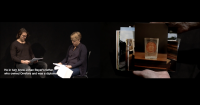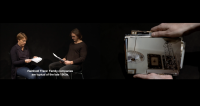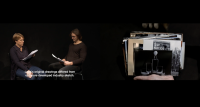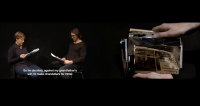In the light and shade of the ornaments-a rehearsal

Two-channel into one-channel, HD-video, 69 min.
Text by Rebecka Thor:
"To reiterate, Rehearsal, Repeat"
To reiterate
Many times, even if I know in fact what the two actors speak about, I am unsure of what is meant, for in "In the light and shade of the ornaments - a rehearsal" (2015), the past becomes the present through just a seemingly small shift. The work is about labour migration from Sudeten Germany to the Swedish glassworks from 1938 until circa 1948. In the text that is read aloud, words such as race indicate a time gone by, as well as the description of the solidarity of the workers' movement, working actively to transport and employ the refugees from Sudeten Germany. Yet, despite this there are several occasions in which I think that what is described is our present. It is a history that repeats itself, that mirrors itself in itself. "In the light and shade of the ornaments - a rehearsal" consists of two video screens, placed on a patterned wallpaper, inspired on a glass by the architect Josef Hoffman. In one video two actors read a script, packed with facts, witness accounts and stories of the Sudeten Germans immigration to Sweden and their relationship to the glass industry. The story is divided in two chapters; a first one with a historical background and an account of the Swedish Workers’ Movement’s engagement; and a second chapter on the glass industry and its art and design history, as well as how these trends spread geographically. In parallel to this, the second video loops as a sort of manual projection of slides where two hands riffle through a think pile of pictures that relate to the script’s narrative.
The work revolves around the population that is called Sudeten Germans. It is a German-speaking population from the Check Republic that was expelled after the end of the Second World War. Yet many social democrats and communist fled to Sweden already before the war, as the region was annexed by Nazi Germany. In Sweden, an “Aid Committee for Sudeten German anti-fascists” was organised which provided refugees with everything from the trip to juridical help and work. Many of these refugees who came earlier and the labour migrants who came later, ended up in the glassworks of Småland after the war. The Swedish glass art that would became so acclaimed rests on these worker’s abilities and knowledge. Jacques Derrida has argued for a view of the archive as a raw material rather than a totalitarian repository of historical truth. The history that we encounter in the archive is thus like a material from the past starting from which we can picture the future. "In the light and shade of the ornaments - a rehearsal" can be understood as a will to relate to history in such a way. Where the past becomes both the now and the future. The work tells something that was, associates it to today and can open up for a discussion of how we want the future to look like. Yet it also poses the viewer the question of how our present will be historicised and reminds us that if we do not act today, we cannot deny our passivity tomorrow.
The work of Ingela Johansson has the word rehearsal in the title. It refers concretely to the recordings’ single take and its effect on the result, retaining the actor’s verbal mistakes, the dropping of script’s pages and the hands’ fumbling with the pictures that are shown. Yet the word acquires another meaning, which for me is even more important, precisely in history’s reiteration. The French root of rehearsal consists of re (iteration) and hercier (to harrow), and creates a motion from the harrowing of the field in agriculture to the harrowing questions of nationality and belonging that resurface again and again.
Rehearsal
The pictures and the recited text run in parallel. The actor’s monotonous reading and the simplicity of the set design are placed alongside the photographs that are flickered through on the second screen. At first the pictures appear as mostly illustrations of the script, but soon they develop into agents from their materiality and create their own narrative. Picture follows picture, like word follows word, sentence follows sentence, until a story comes through. It is these stories that create a parallel to that which the script communicates, both in the sense that the facts blend with the witness accounts and that it is a history that unfolds in the first part and then is taken over, from a different perspective, in the second. Despite this there is something that is not right in the story, when the fact-rich history writing, with references to academic texts as well as interviews with descendants of key people, and pictures is shown appear as equally impotent.
The script is a subjective testimony and the pictures, a sample from an unknown wholeness. The representation of wholeness is, however, itself misleading, for what could repeat that which was in all its aspects? The work operates as an incomplete witness who presents a process and creates a historical writing from a certain perspective. Ever since Herodotus formulated historical writing as a concept has the dictate of saying what is been laid as a ground for our understanding of temporality and at the same time the difficulty for apprehending what was. The testimony is the ground for historical writing—the question is what is included as testimonies and what do we do with it. Which histories can be told and which listened to? And first of all, how do we administer this knowledge? It is in this last question that the work intervenes—for when we listen to this narration we can learn something of the past but also of our present.
Repeat
It is also our vision of history that is at stake – how it engages us and our present. The model of a Hegelian history, grounded in the progress of reason, stands in contrast to an understanding of the past and the present as an eternal spiral that not always leads forward. History repeats itself, it is said, but maybe it is not so much a repetition as it is a retake. Retakes allow differences, clarifications and corrections; it is not the same but there are similarities. These similarities not only exist between then and now, but also between then and then, between parts of the history that are passed down and parts that are forgotten. The white armbands that Sudeten Germans were forced to wear after 1945, marked with an N for Němec, German, and a nazi symbol on the back, marked them out and excluded them from everything from entrance to school to buying the newspaper. They were marked as perpetrators, like the perpetrators marked their victims during the war. (...)
Němec literally means dumb or ”he who does not speak (a slavic language)”. They were old Europe’s strangers – as Ella Shohat has spoken of the internal other in relation to the contemporary external others. The Jews were the symbol for these internal others, but also the Roma, Sudeten Germans and other groups. Many among these still live for generations in different nations without having been granted full citizenship. The dumbness remains, allegorically and actually.




